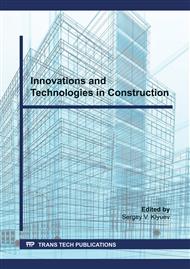p.11
p.21
p.31
p.41
p.51
p.61
p.71
p.81
p.91
Effective Application of 3D Additive Technologies for Creation of Construction Compositions Using Technogenic Raw Materials
Abstract:
Nowadays the great attention of scientists and engineers is attracted by applying 3D-additive technologies for obtaining high-strength fine-grain concrete by using technogenic raw materials. It is distinguished from the conventional concrete by the increased content of cement stone, lower grain size, multicomponent composition and the increased specific surface of the aggregate [1-3]. The performance characteristics of such concrete mostly depend on its aggregate’s properties and water content.The paper considers the problem of improving fine-grain concretes production technologies. For this purpose the opportunities of 3D-additive technologies, which improve the efficiency of fine-grain concretes production technology due to using concrete compositions with natural and technogenic raw materials of various chemical and mineral formulas, were studied. The opportunity of increasing the economic feasibility of high-strength fine-grain concretes, produced by means of 3D-additive technology, with preserving their performance characteristics, has been demonstrated
Info:
Periodical:
Pages:
51-60
Citation:
Online since:
January 2021
Authors:
Price:
Сopyright:
© 2021 Trans Tech Publications Ltd. All Rights Reserved
Share:
Citation:


